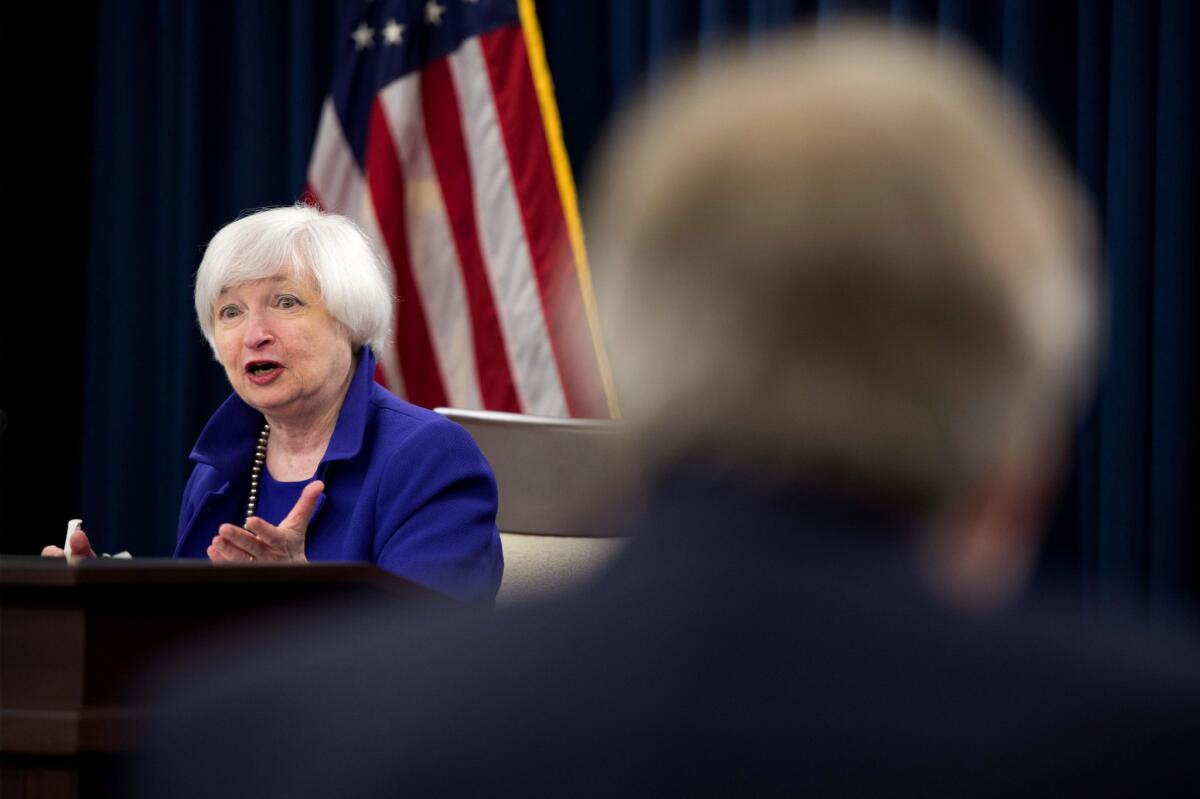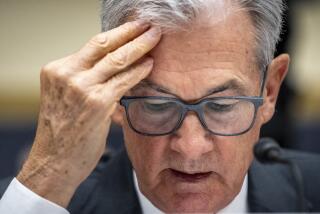What to expect (and not to expect) from the Federal Reserve’s policymaking meeting

Federal Reserve Chairwoman Janet L. Yellen holds a news conference in December.
- Share via
Reporting from Washington — With global financial markets on a mostly downward roller-coaster ride this year, the Federal Reserve is unlikely to raise a key interest rate again when it wraps up its first monetary policy meeting of 2016 on Wednesday.
Instead, central bank officials will try to pack any concerns, reassurances and prognostications into just a handful of paragraphs.
It won’t be easy.
“The Fed has to reassure markets that the sky is not falling with regard to the U.S. economy and they also have to reassure markets that another interest rate hike is not in the immediate offing,” said Greg McBride, chief analyst at financial information website Bankrate.com.
“That’s a tightrope,” he said.
Fed Chairwoman Janet L. Yellen isn’t scheduled to conduct a news conference after Wednesday’s meeting. She holds only four a year and the next one is scheduled for March.
On top of that, the Fed won’t be releasing detailed economic and interest rate projections; those won’t come again until March either.
So Fed policymakers will only be able to issue a short written statement to try to calm jittery investors, businesses and consumers.
See more of our top stories on Facebook >>
“Given the events of the past few weeks, it sure would be nice to have the press conference and economic projections at this meeting, just to get some clarification,” McBride said.
With those limitations, here’s what to expect -- and what not to expect.
No interest rate hike
When Fed officials raised a key interest rate in December for the first time in nearly a decade, they were clear that future hikes would come gradually.
So there was no expectation that the policymaking Federal Open Market Committee would bump up the rate again in January.
Most analysts targeted the next meeting in March because it would give Fed officials time to assess the effects of the initial hike and provide Yellen the news conference platform to explain the decision.
Now that major stock indexes are down significantly to start the year, there’s consensus that the Fed won’t increase the benchmark federal funds rate this week.
McBride put the odds at zero. And all 40 Wall Street experts in a CNBC survey released this week predicted the Fed would hold the rate steady on Wednesday.
Some analysts believe the Fed’s decision to end its unprecedented seven-year stretch of holding the rate near zero helped rattle investors and fueled the recent sell-offs.
But financial markets initially took the 0.25-percentage point December rate hike in stride and only started tumbling in early January after some disappointing economic news from China as well as a continued slide in oil prices.
Regardless, given the recent turmoil, Fed officials are even less likely to enact a rate increase right now. In fact, some experts believe the Fed won’t act in March either and will push off an increase until later in the spring at the earliest.
Little guidance on the next interest rate move
With no news conference or detailed economic projections, the Fed is left with its official policy statement to provide guidance on its next interest rate move.
And the short statement -- usually only about half a dozen paragraphs -- is known for being vague.
The most detailed rate hike guidance recently in one of those statements came in October, when the Fed indicated it could raise the rate in December if the economy had made enough progress on jobs and inflation.
With so much volatility in financial markets now, Fed policymakers aren’t expected to go even that far Wednesday.
The other way the Fed indicates the interest rate outlook is in its quarterly economic projections. Committee members place dots on a chart indicating the midpoint of the target range of the federal funds rate at the end of the year and subsequent years.
But no projections are coming Wednesday.
“There won’t be any indication that policymakers have adjusted their expected path for rates this year,” said Ryan Sweet, an economist at Moody’s Analytics. “They prefer to signal this through their ‘dot graph,’ but the Fed isn’t releasing new economic or interest rate projections this meeting.”
A nod to market turmoil?
The last time financial markets were highly volatile, in late August and early September, the Fed added a sentence to its policy statement acknowledging it.
“Recent global economic and financial developments may restrain economic activity somewhat and are likely to put further downward pressure on inflation in the near term,” the Sept. 17 statement said.
Analysts will look to see if the Fed does that again.
“The question is, does that sentence or a variation thereof make its way back into the January statement,” McBride said.
If the Fed doesn’t include similar language, it could signal that central bank officials aren’t so worried about recent developments and might be more likely to enact another rate increase soon, McBride said.
But a resurrection of the September language could be unsettling to financial markets, said Patrick Schaffer, global investment specialist at J.P. Morgan Private Bank in Los Angeles.
“If they did do that I think it would be indicative of the fact that they’re seeing a bigger slowdown [in the U.S. economy] than we are,” he said.
The state of the U.S. economy
Much of the Fed’s policy statements include an assessment of the U.S. economy and analysts will be watching the wording closely Wednesday for any new warning signs.
The December statement was mostly upbeat.
The Fed said economic activity had been “expanding at a moderate pace,” with “solid rates” of increases in household spending and business investment, as well as “further improvement in housing and the labor market.
The main problems cited were “soft” net exports and inflation that continued to run below the Fed’s 2% annual target. A key reason for the low inflation was the decline in energy prices, whose effects the Fed predicted would be “transitory.”
But oil prices have fallen even further recently. And new indications that China’s economy is slowing more than expected could hurt exports.
Estimates of U.S. economic growth in the fourth quarter of last year are trending down and analysts said the risk of recession this year was rising, though still low.
“A lot more people are going to be keying on the statement to get [the Fed’s] assessment of the downside risks to the economy,” McBride said.
“Every word is parsed,” he continued. “What the Fed says or what the Fed doesn’t say is going to be over-analyzed.”
Follow @JimPuzzanghera on Twitter
MORE FROM BUSINESS
Report: Struggling drugmaker MannKind looking for a buyer
Apple’s growth hits a wall: The iPhone maker’s sales show weakness
Drug kingpin ‘El Chapo’ creates a rush for L.A. clothing firm’s shirts
More to Read
Inside the business of entertainment
The Wide Shot brings you news, analysis and insights on everything from streaming wars to production — and what it all means for the future.
You may occasionally receive promotional content from the Los Angeles Times.











